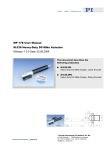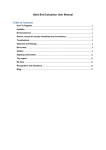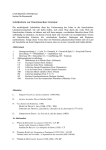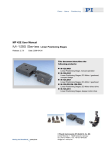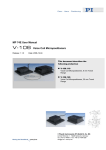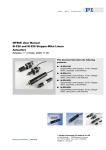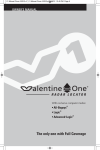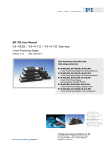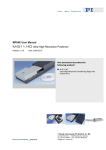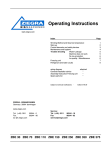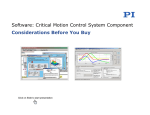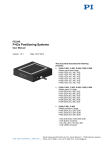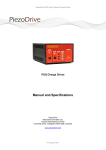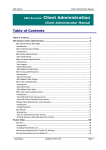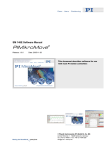Download User Manual MP61E - Physik Instrumente
Transcript
MP61E User Manual M-122 Micro Translation Stage Release: 1.0.0 Datum: 01.08.2007 This document describes the following product: ■ M-122.2DD High-Precision Micro Translation Stage with linear encoder © Physik Instrumente (PI) GmbH & Co. KG Auf der Römerstr. 1 ⋅ 76228 Karlsruhe, Germany Tel. +49 721 4846-0 ⋅ Fax: +49 721 4846-299 [email protected] ⋅ www.pi.ws Physik Instrumente (PI) GmbH & Co. KG is the owner of the following company names and trademarks: PI® The following designations are protected company names or registered trademarks of third parties: LabVIEW Copyright 1999–2007 by Physik Instrumente (PI) GmbH & Co. KG, Karlsruhe, Germany. The text, photographs and drawings in this manual enjoy copyright protection. With regard thereto, Physik Instrumente (PI) GmbH & Co. KG reserves all rights. Use of said text, photographs and drawings is permitted only in part and only upon citation of the source. Erstdruck 01.08.2007 Document Number MP61E BSc, Release 1.0.0 M122_User_MP61E.doc Subject to change without notice. This manual is superseded by any new release. The newest release is available for download at www.pi.ws. (http://www.pi.ws) zum Herunterladen verfügbar. Declaration of Conformity according to ISO / IEC Guide 22 and EN 45014 Manufacturer: Physik Instrumente (PI) GmbH & Co. KG Manufacturer´s Address: Auf der Römerstrasse 1 D-76228 Karlsruhe, Germany The manufacturer hereby declares that the product Product Name: Translation Stage Model Numbers: M-122 Product Options: all complies with the following European directives: 73/23/EWG, Niederspannungsrichtlinie / 73/23/EEC, Low voltage directive 89/336/EWG, EMV- Richtlinie / 89/336/EEC, EMC-Directive 98/37/EG, Maschinenrichtlinie / 98/37/EC, Machinery Directive The applied standards certifying the conformity are listed below. Electromagnetic Emission: EN 61000-6-3, EN 55011 Electromagnetic Immunity: EN 61000-6-1 Safety (Low Voltage Directive): EN 61010-1 Safety of Machinery: EN 12100 July 31, 2007 Karlsruhe, Germany Dr. Karl Spanner President About this Document Users of this Manual This manual is designed to help the reader to install and operate the M-122 Micro Translation Stage. It assumes that the reader has a fundamental understanding of motion control concepts and applicable safety procedures. The manual describes the physical specifications and dimensions of the M-122 Micro Translation Stage as well as the procedures which are required to put the associated motion system into operation. Conventions The notes and symbols used in this manual have the following meanings: WARNING Calls attention to a procedure, practice or condition which, if not correctly performed or adhered to, could result in injury or death. CAUTION Calls attention to a procedure, practice, or condition which, if not correctly performed or adhered to, could result in damage to equipment. NOTE Provides additional information or application hints. The motion controller and the software tools which might be mentioned in this documentation are described in their own manuals. Current releases can be downloaded from the PI Website as PDF files (www.pi.ws (http://www.pi.ws)). For updated releases contact your Physik Instrumente sales engineer or write an email [email protected] (mailto:[email protected]). ! Contents 1 Introduction 1.1 1.2 1.3 1.4 1.5 2 3 Product Description............................................................................. 3 Prescribed Use.................................................................................... 4 Safety Instructions............................................................................... 4 Unpacking ........................................................................................... 5 Accessories......................................................................................... 6 Start-Up 2.1 2.2 2.3 7 Mechanical Mounting .......................................................................... 7 Stacking M-122 stages........................................................................ 8 Interconnecting the System............................................................... 10 Operational Considerations 3.1 3.2 3.3 3.4 3.5 3 12 Linear Encoder.................................................................................. 12 Limit Switches ................................................................................... 12 Reference Switch .............................................................................. 13 Motor Controllers............................................................................... 13 Host PC............................................................................................. 13 4 Maintenance 14 5 Troubleshooting 15 5.1 5.2 Troubleshooting ................................................................................ 15 Customer Service.............................................................................. 16 6 Old Equipment Disposal 17 7 Technical Data 18 7.1 7.2 Specifications .................................................................................... 18 Dimensions ....................................................................................... 19 7.2.1 7.2.2 7.3 Dimensions ......................................................................................... 19 Angle Bracket and Adapter Plate ....................................................... 20 Pin Assignments ............................................................................... 21 7.3.1 Analog DC-Motor Versions................................................................. 21 8 DC Motor Controllers 22 9 Glossary of Terms 25 10 Index 27 Introduction 1 Introduction 1.1 Product Description Figure 1: M-122.2DD micro translation stage (golf ball for size comparison) The M-122 palm-top-sized translation stage combines small dimensions, high speeds and very high accuracy at a competitive price. It features a space-saving, folded drive train with the servo motor and drive screw side-by-side. Equipped with a non-contacting optical linear encoder and a preloaded, precision-ground, ball screw, these stages can provide much higher accuracy and better repeatability than conventional stepper motor stages or rotary encoder-equipped servo motor stages. Low Friction, High Speed, Maintenance-Free Due to its low-friction, the backlash-free ball screw yields significantly higher mechanical efficiency than leadscrews, and allows maintenance-free, high duty-cycle operation at high velocities up to 20 mm/sec. XY and XYZ Combinations M-122 stages can be combined to very compact XY and XYZ systems. The M-122.AP1 mounting bracket is available to mount the Z-axis. www.pi.ws M-122 MP61E Release 1.0.0 Page 3 Introduction 1.2 Prescribed Use Correct operation of the M-122 positioners is only possible in combination with a suitable controller/driver (ordered separately) and software. The controlling device must be able to read out and process the signals from reference and limit switches and the incremental position encoder to ensure proper performance of the servo-control system. Based on their design and realization, the M-122 stages are intended for single-axis positioning, adjusting and shifting of loads at various velocities. M-122 positioners can be mounted horizontically or vertically. To achieve the specified guiding accuracy, the positioners have to be mounted on a flat surface to avoid torsion of the basic profile. The positioners may only be used for applications suitably in accordance with the device specifications. Respect the safety instructions given in this User Manual. The operator is responsible for the correct installation and operation of the M-122. The verification of the technical specifications by the manufacturer does not imply the validation of complete applications. In fact the operator is responsible for the process validation and the appropriate releases. The M-122 meets the specifications as defined by DIN EN 61010 for safe operation under normal ambient conditions. See the specifications table for details (see "Specifications" p. 18). 1.3 Safety Instructions Read carefully the User Manuals of all other components involved such as controllers or software. Read the following before operating the equipment covered in this manual: CAUTION Read this before operating the equipment covered in this manual. Always keep the User Manual safe and close to the described device. In case of loss or damage to the instructions, please order a new copy from your PI distributor or download one from www.pi.ws (http://www.pi.ws). Also keep and add all further information (e.g. extended instructions or Technical Notes) to the User Manual. www.pi.ws M-122 MP61E Release 1.0.0 Page 4 ! Introduction WARNING—CRUSH HAZARD Never put anything where the moving platform or any connected object could possibly trap it! The moving platform can accelerate rapidly and generate high forces which can cause damage or injury. WARNING M-122 stages are powered by powerful electric motors and can accelerate to high speeds. Be aware that automatic limit switch halt may not be supported by, or activated at the motor control electronics. Be aware that failure of the motor controller may drive the mechanics into a hard stop at high speeds. When the mechanics is first connected to the motor controller, be aware that it could start an undesired move. ! CAUTION 1.4 Unpacking Crashes can cause irreparable damage. Do not disable limit switches in software. Test limit switch operation at low speeds. Stop system if necessary. Do not let it run against a hard stop. Unpack the M-122 Micro Translation Stage with care. Compare the contents against the items covered by the contract and against the packing list. The following components are included: ■ M-122 Micro Translation Stage ■ C-815.38 motor cable for connecting to motor controller ■ 000018146 screw set ■ MP61E User Manual for M-122 in printed form (this document) Inspect the contents for signs of damage. If parts are missing or you notice signs of damage, contact PI immediately. www.pi.ws M-122 MP61E Release 1.0.0 Page 5 Introduction Save all packing materials in case the product need be shipped again. 1.5 Accessories The following accessories (see "Angle Bracket and Adapter Plate" p. 20) can be ordered for use with the M-122 Micro Translation Stage: ■ M-110.01: Adapter plate for mount of M-122 stages on honeycomb tables (metric and inch), M-400 and M-500 translation stages and rotation stages ■ M-122.AP1: Angle bracket for vertical mounting of M-122 stages Contact your PI represenstative or write [email protected] if you need additional components. www.pi.ws M-122 MP61E Release 1.0.0 Page 6 Start-Up 2 Start-Up 2.1 Mechanical Mounting The M-122 positioner is usually mounted with its base firmly bolted to a baseplate or another stage (so that the spindle-driven sled is visible). Proceed as follows: 1 Move the sled (blue part of the stage) back and forth to access the mounting holes in the base. You can do this in either of two ways: ■ Connect the positioner to a suitable motor controller (see "DC Motor Controllers" p. 22) and command the necessary motion (see "Interconnecting the System" p. 9). See the User Manual of the controller and any associated software manuals for a detailed description. ■ Move the platform by manually turning the spindle. To do this, use a 1.5 mm Allen wrench (included). Figure 2: Mounting hole in the M-122 base; left hole partially obscured by the sled Figure 3: M-122 with Allen wrench Note Turn the leadscrew / ball screw manually only for mounting or for moving the sled off of a limit switch. 2 www.pi.ws Insert the two mounting screws form the top; tighten and make sure the screw heads do not interfere with the stage motion. M-122 MP61E Release 1.0.0 Page 7 Start-Up 3 To mount an object on the sled of the stage, use M3 screws in the six threaded holes. CAUTION Overlength screws will interfere with motion of the stage and could cause permanent damage! 2.2 Stacking M-122 stages You can assemble stacked XY- or XYZ-systems with M-122 positioners. Be sure to read the chapter "Mechanical Mounting" (p. 7). For assembling, use the included screws. Proceed as follows: www.pi.ws 1 Attach the X-axis positioner to its mounting. 2 If Y-axis motion desired, mount the Y-axis positioner using two of the threaded mounting holes in the sled of the X-axis positioner. 3 If Z-axis motion desired, mount the Z-axis mounting bracket using two of the threaded mounting holes in the sled of the X- or the Y-axis positioner. 4 When the bracket is affixed, attach the Z-axis stage to it in the right orientation (see fig. below). The moveable bearing has to be upturned. M-122 MP61E Release 1.0.0 Page 8 ! Start-Up Figure 4: Assembling M-122 stages to form an XYZ-system, maximum screw length is given in mm www.pi.ws M-122 MP61E Release 1.0.0 Page 9 Start-Up 2.3 Interconnecting the System WARNING—CRUSH HAZARD Never put anything where the moving platform or any connected object could possibly trap it! The moving platform can accelerate rapidly and generate high forces which can cause damage or injury. Figure 5: M-122-2DD: positive direction of motion Prior to operation, you should read the documentation for your motor controller. To operate a stage, proceed as follows: www.pi.ws 1 Install/connect the controller following the instructions in the controller manual. If you are going to use a host computer, install the host software in the host computer. This procedure is described in the controller User Manual and/or associated software manuals. 2 Connect the positioner to the controller using the connecting cable (part number C-815.38). With multi-axis controllers, be sure to note the axis designation of the connection selected. 3 Use the software to adopt the controller to the stage. 4 Command a few test moves to make sure everything is working properly. M-122 MP61E Release 1.0.0 Page 10 Start-Up For best performance and system compatibility we recommend using PI controllers. This User Manual includes a list of suitable controllers (see "DC Motor Controllers" p. 22). Most PI controllers come with a graphic-user-interface-software which is easy to setup and allows quick installation and testing. NOTE Most standard motor controllers and / or software from PI use a database which contains information on all standard micropositioners and installs automatically with the host software. This database, a file called pistages.dat, also includes an initial set of PID servo-control parameters for each stage type. If your system does not use pistages.dat, possible PID parameters are included in this manual. www.pi.ws M-122 MP61E Release 1.0.0 Page 11 Operational Considerations 3 Operational Considerations 3.1 Linear Encoder An optical linear encoder is mounted in the M-122 featuring 0.1 µm resolution. Linear optical encoders measure the actual position directly, thus eliminating drivetrain errors such as non-linearity, backlash or elastic deformations. 3.2 Limit Switches All M-122 positioners are equipped with non-contact, Hall-effect limit switches (with TTL drivers). Each limit switch sends an overtravel signal on its own dedicated line to the controller. It is the controller that is then responsible for stopping the motion. If it does not do so in time, the positioner will run into the hard stop. Limit switch outputs are active-high. CAUTION Crashes can cause irreparable damage. Do not disable limit switches in software. Test limit switch operation at low speeds. Stop system if necessary. Do not let it run against a hard stop. Limit Switch Specifications: www.pi.ws Type: Magnetic (Hall-effect) sensors Supply voltage +5 V / GND, supplied by the motor controller through the motor connector. Signal output: TTL level Sink / source capab. 20 mA at 18 °C Signal logic: Active-high; normal motor operation: low, limit sensor reached: high M-122 MP61E Release 1.0.0 Page 12 ! Operational Considerations 3.3 Reference Switch All stage versions are equipped with a direction-sensing Hall-effect reference switch, which is located at about the midpoint of the travel range. This sensor provides a TTL signal indicating whether the positioner is to the positive or negative side of a fixed point. The rising or falling edge of this signal can be used to indicate a known reference position within 0.5 µm accuracy (depending on the controller). The difference in the reference point when approached from the positive or the negative side is about 0.2 mm to 0.4 mm. See the controller User Manual and/or associated software manuals for the commands which make use of the reference signal. NOTE To obtain best position repeatability it is recommended always to approach the reference point from the same direction. 3.4 Motor Controllers M-122-series micropositioners can be connected to the same motor controllers as other micropositioners from PI. DC motor controllers from PI can control both analog and ActiveDrive™ (PWM) motor versions. The required operating mode is set automatically—depending on the controller model, either directly when the controller is powered up, or when the user chooses the connected positioner type in the control software. If networking several positioners, you have to keep in mind that stepper motor devices can only be networked with other stepper-motor devices. This manual includes a list of suitable controllers. 3.5 Host PC Most controllers from PI are in turn controlled by a host PC provided by the user. The controller is either installed directly in the PC (e.g. C-843 PCI board) or connected to it over a communications interface. See the controller User Manual for details. PI provides software and/or drivers that run on the host PC to control the system. Typically, there will be a control program with a graphic user interface for testing and simple operation, and, in addition, DLL, COM and/or LabView drivers for users who wish to use custom software. If the controller is a PC ISA or PCI card, there will also be hardware drivers to install. See the controller user and software manuals for installation details. www.pi.ws M-122 MP61E Release 1.0.0 Page 13 Maintenance 4 Maintenance When operated in a clean environment, no maintenance is required. www.pi.ws M-122 MP61E Release 1.0.0 Page 14 Troubleshooting 5 Troubleshooting 5.1 Troubleshooting Positioner does not move. Cables not connected properly: ■ Check the connecting cables. Positioner or positioner cable is defective: ■ Replace positioner with a working positioner of the same type to test a new combination of controller and positioner (positioners of a different type may malfunction due to unsuitable parameter settings on the controller). Test cable and / or replace with a working cable of the syme type. Wrong command or wrong syntax: ■ Check the error code (with PI-GCS command set, use ERR?; see controller and software manuals for the error code explanations). Positioner is not referenced: ■ In the GCS command set, some closed-loop motion commands are not executed if the mechanics has not been referenced—(ERR? replies "5", see controller and software manuals). Reference the axis as described in the controller and user manuals. Wrong axis commanded: ■ Check if commanded axis is that of the desired positioner. Incorrect configuration: ■ Check for anomalous parameter settings on the controller. Positioner does not reach position with expected accuracy. Motion parameters are not optimized: www.pi.ws M-122 MP61E Release 1.0.0 Page 15 Troubleshooting ■ Adjust the motion parameters according to the values given in this document. Positioner runs jerkily and not smooth enough. Motion parameters are not optimized: ■ Adjust the motion parameters according to the values listed in this document. Positioner did not stop in time and ran into a hard stop. The controller has not stopped the positioner in time: ■ Too high velocity. See chapter "Limit Switches" (p. 12). 5.2 ■ Turn off the motor. If possible, you may push the positioner out of the end zone manually. ■ The end of the leadscrew has an Allan wrench socket so it can be cranked manually. Customer Service Still having problems? Call your PI representative or write to [email protected]; please have the following information about your system ready: www.pi.ws ■ Product codes and serial numbers of all products in the system ■ Current firmware version of the controller (if present) ■ Version of drivers and / or host software (if present) ■ Operating system on host PC (if present) M-122 MP61E Release 1.0.0 Page 16 Old Equipment Disposal 6 Old Equipment Disposal In accordance with EU directive 2002 / 96 / EC (WEEE), as of 13 August 2005, electrical and electronic equipment may not be disposed of in the member states of the EU mixed with other wastes. To meet the manufacturer’s product responsibility with regard to this product, Physik Instrumente (PI) GmbH & Co. KG will ensure environmentally correct disposal of old PI equipment that was first put into circulation after 13 August 2005, free of charge. If you have such old equipment from PI, you can send it to the following address postage-free: Physik Instrumente (PI) GmbH & Co. KG Auf der Römerstr. 1 76228 Karlsruhe, Germany www.pi.ws M-122 MP61E Release 1.0.0 Page 17 Technical Data 7 Technical Data 7.1 Specifications M-122.2DD Active axes X Motion and positioning Travel range Integrated sensor 25 mm Linear encoder Sensor resolution Design resolution 0.1 µm 0.1 µm Min. incremental motion 0.2 µm Backlash 0.2 µm Unidirectional repeatability 0.15 µm Pitch Yaw Max. velocity ±150 µrad ±150 µrad 20 mm/s Origin repeatability 1 µm Mechanical properties Drive screw Recirculating ballscrew Thread pitch Stiffness in motion direction 0.5 mm 0.25 N/µm Max. load Max. push/pull force Max. lateral force 50 N 20 N 25 N Drive properties Motor type DC motor Operating voltage 0 to ± 12 V (differential) Electrical power 2.25 W Limit and reference switches Hall-effect Miscellaneous www.pi.ws Operating temperature range -20 to +65 Material Aluminum, steel Dimensions Mass Recommended controller/driver 86 x 60 x 20.5 mm 0.22 kg C-862 (single-axis) C-843 PCI board (up to 4 axes) M-122 MP61E Release 1.0.0 Page 18 Technical Data 7.2 Dimensions All dimensions in mm, decimal places separated by commas in drawings 7.2.1 Dimensions Figure 6: M-122.2DD, dimensions in mm www.pi.ws M-122 MP61E Release 1.0.0 Page 19 Technical Data 7.2.2 Angle Bracket and Adapter Plate Figure 7: M-122.AP1 adapter bracket, dimensions in mm Figure 8: M-110.01 Adapter plate for mounting on Honeycomb-stages www.pi.ws M-122 MP61E Release 1.0.0 Page 20 Technical Data 7.3 Pin Assignments 7.3.1 Analog DC-Motor Versions Connector type on motor: Sub-D 15m Pin# Signal 1 9 2 10 3 11 4 12 5 13 6 14 7 15 8 Direction n.c. MOT (-) MOT (+) PGND n.c. n.c. +5V NLIM PLIM REFS GND A (+) A (-) B (+) B (-) input input input input output output output output output output output Function not connected motor connection (-)* motor connection (+)* ground (power) not connected not connected +5 V input for encoder and logic negative limit signal (active high), TTL positive limit signal (active high), TTL position reference signal, TTL ground (logic) encoder signal A, TTL encoder signal A-dash, TTL encoder signal B, TTL encoder signal B-dash, TTL * Polarity determines direction of motion: if MOT+ > MOT- motion is in the positive direction, i.e. away from the end where the motor is mounted. www.pi.ws M-122 MP61E Release 1.0.0 Page 21 DC Motor Controllers 8 DC Motor Controllers M-122 positioners can be used with the C-843 motor controller card or C-862 Mercury™ controllers. Drive type DC Motor Controller Axes per controller C-862 Mercury™ 1 RS-232 bus or daisy chain Host PC interface Multiple controllers on yes, same or separate ports same host PC C-843 motor controller card 2 or 4 Internal (PCI bus) yes, separate slots NOTE Most standard motor controllers and / or software from PI use a database which contains information on all standard micropositioners and installs automatically with the host software. This database, a file called pistages.dat, also includes an initial set of PID servo-control parameters for each stage type. If your system does not use pistages.dat, possible PID parameters are included in this manual. Parameter settings for C-862 Mercury™ DC-Motor Controller The C-862 Mercury™ Controller is a compact palm-size, single-axis controller. C-862s are daisy-chain networkable and a multi-axis system can be controlled from a single PC RS-232 interface. The Windows operating program for the C-862 Mercury™ controller allows choice of micropositioners as a start-up option for operation. The C-862 Mercury™ has the correct operating mode (analog or PWM) automatically enabled with no extra command required. www.pi.ws M-122 MP61E Release 1.0.0 Page 22 DC Motor Controllers Appropriate Parameters for M-122.2DD www.pi.ws Parameter p-term i-term d-term i-limit Recommended Value 180 1800 140 2000 Velocity [cts/s] Velocity [mm/s] Acceleration [cts/s²] Acceleration [mm/s]² 200,000 20.0 400,000 40.0 M-122 MP61E Release 1.0.0 Page 23 9 Glossary of Terms Backlash Position error that appears upon reversing direction. Backlash is caused by play in the drive train components coming after the encoder, such as gearheads or bearings, and by friction in the guiding system. Unlike hysteresis, it can lead to instability in closed-loop setups because it causes a deadband in the servo-loop. Some manufacturers promote controllers with automatic backlash compensation that add the estimated amount of lost motion upon each reversal. This solution is very limited in practice, as backlash is not constant but varies with temperature, deceleration, acceleration, load, leadscrew position, direction, wear, etc. Bidirectional Repeatability The accuracy of returning to a position from any position, regardless of direction. Effects such as hysteresis and backlash affect bidirectional repeatability. See also "Unidirectional Repeatability". DC Servo-Motor A direct-current motor that is operated in a closed-loop system (servo-loop). Characteristics of DC servo-motors are lack of vibration, smooth running, wide speed range and very good low-speed torque. For optimum performance, a good motor controller with PID (proportional, integral, derivative) algorithm and filter settings is mandatory. Design Resolution The theoretical minimum movement that can be made. This is a calculated value based on the drive components (drive screw pitch, gear ratio, motor angular resolution etc.) and does not account for nonlinearities like friction, backlash, etc. Design resolution must not be confused with minimum incremental motion. In systems with high gear ratios or microstepping motors, the design resolution can be in the subnanometer range. In practice, incremental motion of less than 0.1 µm is prevented by guiding system friction (except with air bearings and flexures). Maximum Push/Pull Force Active and passive force limit in operating direction, at center of stage. Some stages may be able to generate higher forces at the cost of reduced lifetime. Minimum Incremental Motion The minimum motion that can be repeatedly executed for a given input, which is sometimes referred to as practical or operational resolution. Design resolution and practical resolution must be distinguished. Design resolutions of 1 nm or better can be achieved with many motor, gearbox and leadscrew combinations. In practical applications, however, stiction/friction, windup, and elastic deformation limit resolution to fractions of a micron. Minimum incremental motion must be determined by actual measurements. Repeatable nanometer or sub-nanometer resolution can be provided by solid-state actuators (PZTs) and PZT flexure stages (see the "PZT Flexure NanoPositioners" and "PZT Actuators" sections of the PI Catalog for details) such as those integrated in PI's M-511.HD and M-714 Hybrid Drive stages. Unidirectional Repeatability The accuracy of returning to a given position from the same direction. Because unidirectional repeatability is almost unaffected by backlash and hysteresis, it is often considerably better than bidirectional repeatability. 10 Index A Accessories • 6 Analog DC-Motor Versions • 21 Angle Bracket and Adapter Plate • 6, 20 B Backlash • 25 Bidirectional Repeatability • 25 C Customer Service • 16 D DC Motor Controllers • 7, 11, 22 DC Servo-Motor • 25 Design Resolution • 25 Dimensions • 19 H Host PC • 13 I Interconnecting the System • 7, 10 Introduction • 3 L Limit Switches • 12, 16 Linear Encoder • 12 M Maintenance • 14 Maximum Push/Pull Force • 25 Mechanical Mounting • 7, 8 Minimum Incremental Motion • 26 Motor Controllers • 13 O Old Equipment Disposal • 17 Operational Considerations • 12 P Pin Assignments • 21 Prescribed Use • 4 Product Description • 3 R Reference Switch • 13 S Safety Instructions • 4 Specifications • 4, 18 Stacking M-122 stages • 8 Start-Up • 7 T Technical Data • 18 Troubleshooting • 15 U Unidirectional Repeatability • 26 Unpacking • 5
































